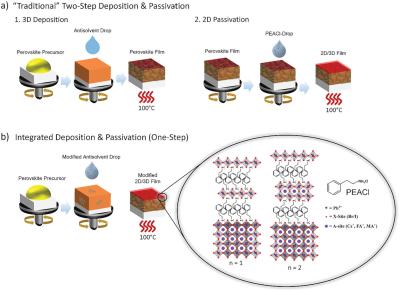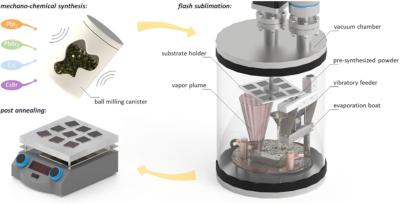What are perovskite?
Perovskites are a class of materials that share a similar structure, which display a myriad of exciting properties like superconductivity, magnetoresistance and more. These easily synthesized materials are considered the future of solar cells, as their distinctive structure makes them perfect for enabling low-cost, efficient photovoltaics. They are also predicted to play a role in next-gen electric vehicle batteries, sensors, lasers and much more.
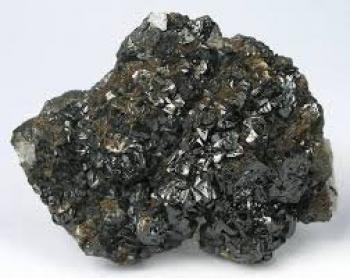
How does the PV market look today?
In general, Photovoltaic (PV) technologies can be viewed as divided into two main categories: wafer-based PV (also called 1st generation PVs) and thin-film cell PVs. Traditional crystalline silicon (c-Si) cells (both single crystalline silicon and multi-crystalline silicon) and gallium arsenide (GaAs) cells belong to the wafer-based PVs, with c-Si cells dominating the current PV market (about 90% market share) and GaAs exhibiting the highest efficiency.
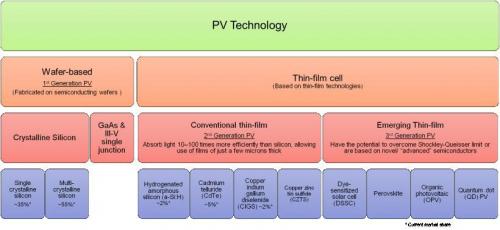
Thin-film cells normally absorb light more efficiently than silicon, allowing the use of extremely thin films. Cadmium telluride (CdTe) technology has been successfully commercialized, with more than 20% cell efficiency and 17.5% module efficiency record and such cells currently hold about 5% of the total market. Other commercial thin-film technologies include hydrogenated amorphous silicon (a-Si:H) and copper indium gallium (di)selenide (CIGS) cells, taking approximately 2% market share each today. Copper zinc tin sulphide technology has been under R&D for years and will probably require some time until actual commercialization.
What is a perovskite solar cell?
An emerging thin-film PV class is being formed, also called 3rd generation PVs, which refers to PVs using technologies that have the potential to overcome current efficiency and performance limits or are based on novel materials. This 3rd generation of PVs includes DSSC, organic photovoltaic (OPV), quantum dot (QD) PV and perovskite PV.
A perovskite solar cell is a type of solar cell which includes a perovskite structured compound, most commonly a hybrid organic-inorganic lead or tin halide-based material, as the light-harvesting active layer. Perovskite materials such as methylammonium lead halides are cheap to produce and relatively simple to manufacture. Perovskites possess intrinsic properties like broad absorption spectrum, fast charge separation, long transport distance of electrons and holes, long carrier separation lifetime, and more, that make them very promising materials for solid-state solar cells.
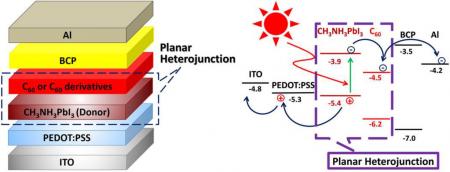
Perovskite solar cells are, without a doubt, the rising star in the field of photovoltaics. They are causing excitement within the solar power industry with their ability to absorb light across almost all visible wavelengths, exceptional power conversion efficiencies already exceeding 20% in the lab, and relative ease of fabrication. Perovskite solar cells still face several challenge, but much work is put into facing them and some companies, are already talking about commercializing them in the near future.
What are the advantages of Perovskite solar cells?
Put simply, perovskite solar cells aim to increase the efficiency and lower the cost of solar energy. Perovskite PVs indeed hold promise for high efficiencies, as well as low potential material & reduced processing costs. A big advantage perovskite PVs have over conventional solar technology is that they can react to various different wavelengths of light, which lets them convert more of the sunlight that reaches them into electricity.
Moreover, they offer flexibility, semi-transparency, tailored form factors, light-weight and more. Naturally, electronics designers and researchers are certain that such characteristics will open up many more applications for solar cells.
What is holding perovskite PVs back?
Despite its great potential, perovskite solar cell technology is still in the early stages of commercialization compared with other mature solar technologies as there are a number of concerns remaining.
One problem is their overall cost (for several reasons, mainly since currently the most common electrode material in perovskite solar cells is gold), and another is that cheaper perovskite solar cells have a short lifespan. Perovskite PVs also deteriorate rapidly in the presence of moisture and the decay products attack metal electrodes. Heavy encapsulation to protect perovskite can add to the cell cost and weight. Scaling up is another issue - reported high efficiency ratings have been achieved using small cells, which is great for lab testing, but too small to be used in an actual solar panel.
A major issue is toxicity - a substance called PbI is one of the breakdown products of perovskite. This is known to be toxic and there are concerns that it may be carcinogenic (although this is still an unproven point). Also, many perovskite cells use lead, a massive pollutant. Researchers are constantly seeking substitutions, and have already made working cells using tin instead. (with efficiency at only 6%, but improvements will surely follow).
What’s next?
While major challenges indeed exist, perovskite solar cells are still touted as the PV technology of the future, and much development work and research are put into making this a reality. Scientists and companies are working towards increasing efficiency and stability, prolonging lifetime and replacing toxic materials with safer ones. Researchers are also looking at the benefits of combining perovskites with other technologies, like silicon for example, to create what is referred to as “tandem cells”.
Commercial activity in the field of perovskite PV
In September 2015, Australia-based organic PV and perovskite solar cell (PSC) developer Dyesol declared a major breakthrough in perovskite stability for solar applications. Dyesol claims to have made a significant breakthrough on small perovskite solar cells, with “meaningful numbers” of 10% efficient strip cells exhibiting less than 10% relative degradation when exposed to continuous light soaking for over 1000 hours. Dyesol was also awarded a $0.5 million grant from the Australian Renewable Energy Agency (ARENA) to commercialize an innovative, very high efficiency perovskite solar cell.
Also in 2015, Saule Technologies signed an investment deal with Hideo Sawada, a Japanese investment company. Saule aims to combine perovskite solar cells with other currently available products, and this investment agreement came only a year after the company was launched.
In October 2020, Saule launched sunbreaker lamellas equipped with perovskite solar cells. The product is planned to soon be marketed across across Europe and potentially go global after that.
In August 2020, reports out of China suggested that a perovskite photovoltaic cell production line has gone into production in Quzhou, east China's Zhejiang Province. The 40-hectare factory was reportedly funded by Microquanta Semiconductor and expected to produce more than 200,000 square meters of photovoltaic glass before the end of 2020.
In September 2020, Oxford PV's Professor Henry Snaith stated that the Company's perovskite-based solar cells are scheduled to go on sale next year, probably by mid 2021. These will be perovskite solar cells integrated with standard silicon solar cells.
The latest perovskite solar news:
Researchers develop integrated deposition and passivation strategy for controlled crystallization of 2D/3D halide perovskite films
Researchers from the University of Stuttgart, Lawrence Berkeley National Laboratory and Brandenburg University of Technology Cottbus-Senftenberg have introduced a simplified deposition procedure for multidimensional (2D/3D) perovskite thin films, integrating a phenethylammonium chloride (PEACl)-treatment into the antisolvent step when forming the 3D perovskite.
The “traditional” deposition and passivation processes (top row) and the integrated deposition and passivation strategy to form 2D passivated 3D halide perovskite films (bottom row). Image from Advanced Materials.
This recently developed simultaneous deposition and passivation strategy reduces the number of synthesis steps while simultaneously stabilizing the halide perovskite film and improving the photovoltaic performance of resulting solar cell devices to 20.8%.
Researchers develop flexible quasi-2D perovskite solar cells with high specific power and improved stability for energy-autonomous drones
Researchers at Austria's Johannes Kepler University Linz have developed lightweight, thin (<2.5 μm), flexible and transparent-conductive-oxide-free quasi-two-dimensional perovskite solar cells by incorporating alpha-methylbenzyl ammonium iodide into the photoactive perovskite layer.
The team fabricated the devices directly on an ultrathin polymer foil coated with an alumina barrier layer to ensure environmental and mechanical stability without compromising weight and flexibility.
Researchers highlight the potential of ambient air annealing for efficient inorganic CsPbI3 perovskite solar cells
Researchers from Helmholtz-Zentrum Berlin (HZB) and the University of Potsdam have analyzed surfaces and interfaces of CsPbI3 films, produced under different conditions, at BESSY II. They found that annealing in ambient air does not have an adverse effect on the optoelectronic properties of the semiconductor film, but actually results in fewer defects. This could simplify the mass production of inorganic perovskite solar cells.
The best performing perovskite semiconductors contain organic cations such as methylammonium, which cannot tolerate high temperatures and humidity, so their long-term stability is still a challenge. However, methylammonium can be replaced by inorganic cations such as Cesium (Cs). Inorganic halide perovskites with the molecular formula CsPbX3 (where X stands for a halide such as chloride, bromide and iodide) remain stable even at temperatures above 300 °C. CsPbI3 has the best optical properties for photovoltaics (band gap ∼1.7 eV).
Researchers develop novel vapor deposition technique based on continuous flash sublimation for rapid fabrication of all-inorganic perovskite solar cells
Researchers at NREL, BlueDot Photonics, University of Washington, Colorado School of Mines and Rochester Institute of Technology have developed a vapor deposition technique based on continuous flash sublimation (CFS) to fabricate all-inorganic perovskite thin films in under 5 minutes in a continuous process. The adoption of the proposed approach may also result in higher power conversion efficiencies of perovskite solar cell.
Schematic illustration of the continuous flash sublimation (CFS) approach consisting of a mechano-chemical synthesis of the source powder (here CsPb(IxBr1−x)3), the high-throughput deposition process in a home-made evaporation system, and a short post-annealing treatment to improve thin-film quality. Image from Journal of Materials Chemistry A
The team described the new technique as a non-batch process that solves two problems associated with the use of established vapor processing in perovskite material manufacturing – the slow speed of deposition and the non-continuous nature of batch processing.
Researchers develop strategy that yields 24.67%-efficiency doctor-bladed perovskite solar cells
Scalable deposition of high-efficiency perovskite solar cells (PSCs) is vital to achieving commercialization. However, a significant number of defects are distributed at the buried interface of perovskite film fabricated by scalable deposition, which adversely affects the efficiency and stability of PSCs. Now, researchers at China's Central South University, Hunan Institute of Engineering and Chinese Academy of Sciences (CAS) addressed this issue by incorporating 2-(N-morpholino)ethanesulfonic acid potassium salt (MESK) as the bridging layer between the tin oxide (SnO2) electron transport layer (ETL) and the perovskite film deposited via scalable two-step doctor blading.
The scientists reported that both experiment and simulation results demonstrated that MESK can passivate the trap states of Sn suspension bonds, thereby enhancing the charge extraction and transport of the SnO2 ETL.
Perovskite-Info updates its Perovskite for the Solar Industry Market Report
We have released a new edition of the Perovskites for the Solar Industry market report. This report, over 140 pages long, is a comprehensive guide to next-generation perovskite-based solutions for the solar industry that enable efficient, low cost, lightweight and unique solar solutions. The new edition includes over 15 new updates, and over 15 new companies that are now included in the report. The perovskite industry is moving fast towards commercialization and our report is a must-read for anyone that wishes to become an expert on this emerging industry and market.
Reading this report, you'll learn all about:
- The perovskite solar industry and market
- The advantages and challenges of perovskite PVs
- Perovskite PV developers and supply chain companies
- What the future holds for the perovskite market and industry
The report also provides:
- Market segmentation by technology, geography, applications and more
- The latest efficiency records (by PV type)
- Details on perovskite collaborative research projects
- A market snapshot and forecast
- Free updates for a year
Researchers use ligand-passivation engineering to achieve high performance indoor perovskite quantum dot photovoltaics
Researchers at Korea University, Kyungpook National University, Hanyang University, Dongguk University and Mississippi State University have used a novel ligand passivation strategy in perovskite quantum dots (PQDs) photovoltaics (PQDPVs) to enhance the carrier lifetime.
The advancement of perovskite photovoltaic (PePV) systems for harnessing indoor light energy has been accelerated by the advent of the Internet of Things (IoT). However, the commercialization of these systems is impeded by moisture instability and restricted carrier lifetimes. Perovskite quantum dots (PQDs) offer viable solutions for increasing stability despite the potential effects of their organic ligands on efficiency.
Researchers develop record efficiency inverted PSCs by improving charge extraction with dual-site-binding ligands
Researchers from Northwestern University, University of Toronto, ShanghaiTech University, University of Victoria and Arizona State University have developed highly stable, highly efficient 0.05cm2 perovskite solar cell with a PCE of 26.15%, certified by a National Renewable Energy Laboratory-accredited facility. The team said that the prior certified world record published in a scientific journal was 25.73%.
A 1.04 cm2 device had a certified power conversion efficiency of 24.74%, also a record for its size. The best devices retained 95% of their initial PCE following 1,200 hours of continuous solar illumination at a temperature of 65 degrees.
Researchers provide a roadmap for the optical properties of perovskite/perovskite/silicon triple-junction cells
Researchers from the University of Freiburg and Fraunhofer ISE recently put together a roadmap for the optical properties of perovskite/perovskite/silicon triple-junction cells. They investigated the optical properties of perovskite/perovskite/silicon triple-junction cells and found these devices may have a practical efficiency potential of 44.3% assuming idealized electrical parameters. These cells may also potentially achieve a fill factor of 90.1%.
The group of researchers developed a comprehensive optoelectrical simulation model for triple-junction solar cells based on subcells relying on perovskite, perovskite, and crystalline silicon, respectively. The model aims to define an efficiency roadmap for improving the optical properties of these solar cells within realistic boundary conditions.
Researchers rely on machine learning predictions for efficient perovskite solar cell development
Researchers at Shanghai Jiao Tong University, Shanghai University of Electric Power and Shandong Normal University have addressed the traditional trial-and-error method for preparing high-efficiency perovskite solar cells (PSCs) by introducing a goal-driven approach that integrates machine learning and data mining techniques to rapidly screen high-efficiency PSCs based on key features.
By predicting high-efficiency PSCs and identifying the dominant factors affecting their performance, namely the perovskite bandgap and the total thickness of the electron transport layer (ETL), this research aims to provide valuable insights for optimizing preparation processes and advancing the development of high-efficiency PSCs, thus significantly contributing to the renewable energy sector.
Pagination
- Page 1
- Next page
